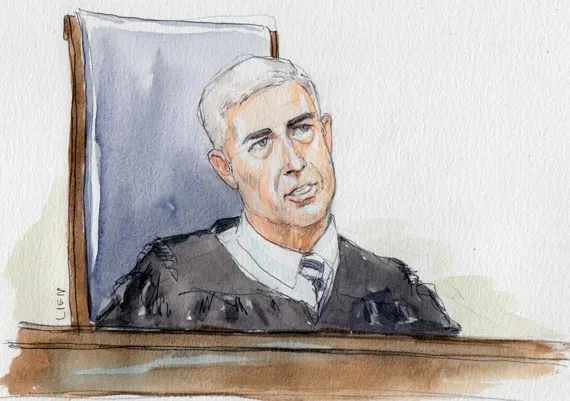SCOTUS for law students: Waiting for Gorsuch

on May 18, 2017 at 10:15 am

Justice Neil Gorsuch has cast his first consequential vote on the Supreme Court, denying a request for a stay of execution filed by several death-row inmates, and participated – actively, by many accounts – in the court’s April argument session. The next major milestone for the newest justice will be his first majority opinion for the court.
If history is a guide, the moment, which is likely to occur in the next six weeks before the court recesses for the summer, will be more memorable as a rite of passage than as a landmark of the law.
What Gorsuch is writing will remain secret until the decision is announced. In all likelihood, however, Gorsuch was quickly assigned a majority opinion to write by Chief Justice John Roberts after taking part in 13 oral arguments between April 17 and April 26. Under the court’s practice, when the chief justice is in the majority, he makes the assignments for majority opinions in the cases; if the chief justice is in dissent, then the senior associate justice in the majority makes the assignment, most often Justice Anthony Kennedy on the current court.

Justice Neil Gorsuch (Art Lien)
For some part of the court’s history, this next step for Gorsuch would have been governed by well-established and much-respected tradition. According to custom, a new justice’s first opinion assignment was in a deliberately uncontroversial case, and all of the other justices would take pains to join the opinion and make it unanimous. The purpose of the tradition was apparently to welcome the new justice with a show of the collegiality on which the court prides itself. So settled was this custom that when Justice William Brennan issued his first decision on December 3, 1956, an 8-1 ruling in a tax case (Putnam v. Commissioner of Internal Revenue), the dissenting Justice John Harlan wrote him privately to say he was “sorry” that he could not “sign up at once with your first.”
The current vitality of this practice is a subject of some debate. Commentators and bloggers about the court still refer to the tradition. If the tradition still exists, however, it seems to be honored only some of the time. Among the eight justices whom Gorsuch joined on April 10, half of them, appointed by Republican presidents, wrote unanimous first decisions and the other half, appointed by Democrats, did not.
Among the longest-serving justices, the first decisions of Kennedy in 1988 and Justice Clarence Thomas in 1992 were unanimous. Among the more junior justices, the first opinions of Roberts in 2005 and Justice Samuel Alito in 2006 were also unanimous.
Other current members of the court did not have the same experience. Justice Ruth Bader Ginsburg’s first in 1993 was decided 6-3 with Thomas in dissent, joined by Kennedy and Justice Sandra Day O’Connor. Justice Stephen Breyer’s first in 1995 was 7-2 with Thomas and Justice Antonin Scalia each dissenting.
Ginsburg recalled in 2015 what happened when she announced her first decision, John Hancock Mutual Life Insurance Co. v. Harris Trust and Savings Bank, a ruling on the complicated Employee Retirement Income Security Act. As Ginsburg read a summary in the courtroom, she said, O’Connor, despite joining the dissent, wrote her a note that said, “This is your first opinion for the court. It is a fine one. I look forward to many more.”
Ginsburg said she wrote similar notes to Justices Sonia Sotomayor and Elena Kagan when they announced their first decisions. Those notes were likely very welcome, because both Sotomayor’s and Kagan’s first decisions prompted some of their colleagues to write separately.
Sotomayor’s first opinion in 2009 occasioned an opinion concurring in part and concurring in the judgment by Thomas. Although Thomas agreed with the outcome in Mohawk Industries, Inc. v. Carpenter, a civil procedure ruling, his separate opinion provoked commentary about its tone, especially given that it was Sotomayor’s first decision. Thomas concluded his opinion by criticizing the “value judgments” in which he said Sotomayor “subordinated what the appellate jurisdiction statute says to what the Court thinks is a good idea.” One news story at the time reported that Thomas “took a swipe at his new colleague.”
Kagan’s first decision in 2011 was accompanied by a Scalia dissent. Ransom v. FIA Card Services, N.A. was a bankruptcy ruling. In dissent, Scalia set forth a straightforward legal disagreement with Kagan, omitting the strong language that often marked the late justice’s dissents.
How quickly might Gorsuch produce his first opinion? Among the current justices, Roberts was the fastest, turning out his first decision about four weeks after oral argument. Kennedy was a close second, taking about five weeks.
Much can be learned from a justice’s decisions, but the lessons from the very first decision may be limited. Eventually justices make basic style choices: whether to reveal the result at the beginning of the opinion or only at the end; whether to minimize or make full use of footnotes; what tone to adopt in writing; how much to respond to dissenting opinions. Court watchers will look for such clues in Gorsuch’s first opinion, but those hints may be hard to find.
If past practice is followed, it will also be difficult to gain any ideological insight from Gorsuch’s first decision. Tradition has it that the first decision for a justice is generally in a case that is not one of the more controversial or visible of the term, so this one may shed little light on Gorsuch’s analytical approach to important issues.
Gorsuch’s first decision is likely to become a footnote to history, eclipsed by a long career on the Supreme Court bench. For now, though, it is a milestone eagerly awaited.


